How Much Does It Cost to Promote Instagram Posts? An In-Depth Guide
Much like other forms of online advertising, paying to promote on Instagram can seem pretty daunting for new advertisers.
There’s so much to consider: what to promote, how to promote it, where to place the ad, etc. Not to mention all the research that goes into creating a winning ad campaign.
But the trickiest part of Instagram advertising remains the one that confuses beginners every time — those sneaky costs! Luckily, our social media marketing experts are revealing all the answers you’re looking for in this detailed guide.
So, let’s get into it. Let’s demystify Instagram ad costs and all the different factors that influence them. Learn about advertising options offered by Instagram, strategies to calculate Instagram ad costs, and expert tips to minimize your ad spend with us!
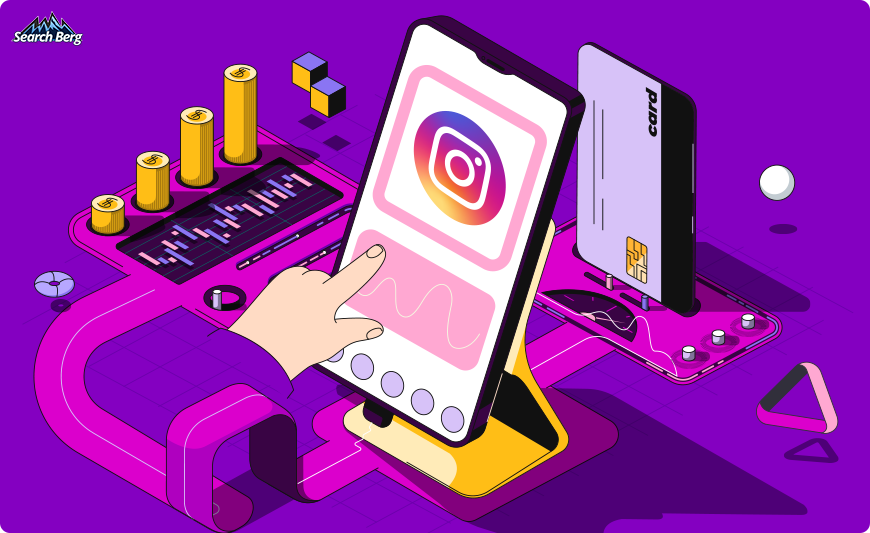
Why Promote on Instagram in the First Place?
Instagram has become an integral part of every digital marketer’s social media marketing mix. If you approach a social media management company for guidance, it’ll likely suggest building an Instagram presence for your brand. Why? Because Instagram is one of the best platforms for brand visibility in 2023, regardless of your industry!
Since its launch in 2010, the picture-sharing app has quickly grown into one of the world’s most-used social media platforms. It consistently ranks among the top five most popular social networks, with over 2 billion active users as of 2023.
Instagram’s vast user base is projected to grow as more people join social media platforms worldwide. As an online business owner, this should tell you two things:
- A large chunk of your potential customer base is on Instagram,
- You can boost visibility for your online brand by promoting it on Instagram!
Not convinced? The platform has more to offer than millions of active users. Here are some of the top benefits for online businesses:
- High Engagement Rates: If you’re looking for active and engaged users, Instagram is where you’ll find them. The app has the second-highest engagement rate across all post types, fluctuating between 0.6% to 0.9% depending on the post format. The video-sharing app TikTok takes the first spot, thanks to the rise of vertical online videos.
Recommended read: How Vertical Video Is Shaping Content Marketing in 2023
- Diverse Advertising Options: Every online business can benefit from Instagram’s diverse and optimized paid advertising options. The app makes the process of ad budget allocation and targeted advertising easier than ever. It lets users create custom target audiences based on interests, locations, ages, and other relevant demographics. These options allow advertisers to target the right audience, ultimately leading to higher conversions.
- Seamless Lead Generation: The Instagram app has a ton of built-in features for lead generation, making it easier for brands to farm direct user interactions. You can add a link to your Instagram account bio, enable “Message,” “Contact,” and “Directions” buttons on your profile, and include call-to-action buttons in your ads.
- Collaborative Features: Instagram is great for building connections and communities, given the app’s unique collaborative features. Industry peers can enter partnerships, share insights, and publish combined posts using the app’s Collab Posts Other collaborative features include tagging, reposts, mentions, and Instagram Lives with invited guests.
- Unique Ad Formats: When it comes to ad formats, Instagram offers one of the widest ranges for advertisers to choose from. More on this below!
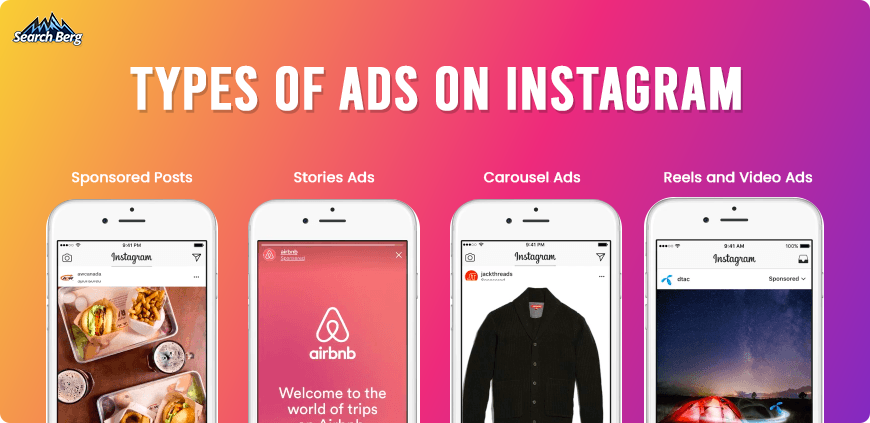
Instagram Advertising Options: An Overview
Before we can dive into the nitty-gritty of paying to promote on Instagram, let’s discuss how you can even do that.
Since Instagram is owned by Meta, which is also Facebook’s parent company, you can manage ads for both platforms through Meta Ads Manager. All you have to do is set up a Facebook Business Page, open your automatically-created Ads Manager account, and connect your professional Instagram profile with it.
Then, you can start running ads. Here are the unique and effective options you have for advertising on Instagram.
1. Sponsored Posts
If you want to convert posts that are already posted on your feed into ads, you can do that with Instagram’s Sponsored Posts feature.
Sponsored posts are the simplest way to promote on Instagram. They allow you to “boost” any post or reel on your profile. All you have to do is click on a post, select the ‘Boost Post’ option, and start curating your ad campaign. You can then select an advertising goal, choose or create a target audience, and decide on a budget.

When deciding which post to boost, consider the following:
- Relevance: The post you boost should be aligned with your advertising goal, whether it’s to increase brand awareness, drive website traffic, or boost engagement. Choose a post that already contains elements that directly relate to your marketing objectives.
- Engagement: Unless you’ve published the post you’re boosting too recently, there will probably already be some engagement on it. Choose a post that has a good amount of likes, comments, and saves so you can build on that activity instead of starting from scratch.
- Content Quality: Choose a post that has compelling visuals and an enticing caption. Sponsored posts only perform well when they contain high-quality content. Make sure there’s already a call-to-action element in your boosted posts, too. This way, generating leads will become easier when you promote on Instagram.
2. Stories Ads
Stories is a great feature to leverage for online brands and businesses of all sizes. Instagram Stories allow users to display vertical images and videos of any length up to 60 seconds.
Since mobile users started dominating the online market, marketers have learned to prioritize ad formats that work best on mobile devices. Vertical images and videos are among them, and Instagram Stories is arguably the best platform to support these formats.
Now, Stories themselves are short-lived, i.e., only staying up for 24 hours. However, you can run ads on Stories for much longer. You can set the time and day durations for your ads based on your campaign goals.
Stories Ads appear in between regular Stories as users swipe on their app. This makes them great at blending in and grabbing attention. What makes Stories ads great for promoting on Instagram is that you can include direct swipe-up links, CTA buttons, profile redirects, and other lead magnets in the ads.
Take these Hostinger and GoDaddy ads, for example. Notice how easy they make it for users to connect with the respective company?
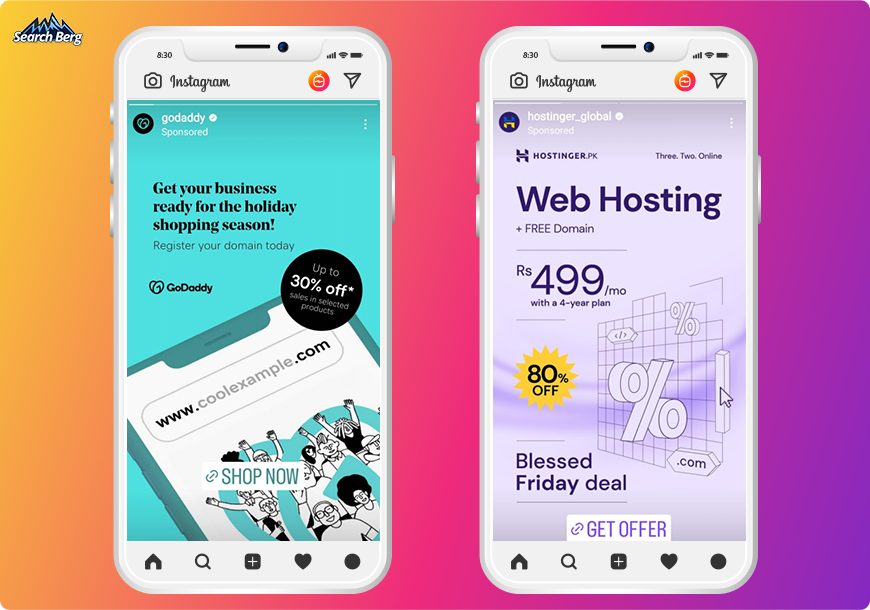
3. Carousel Ads
Instagram does carousel posts better than any other app. Not only can you upload more than ten attachments in one post (or ad!), but all of these attachments can be different content formats, i.e. videos or static images.
Making a carousel ad on Instagram is easy, too. You create it like you’d create any other ad, except with more pictures or videos. Why would you run a carousel ad to promote on Instagram instead of a regular static image ad? Because it might generate better results!
Studies have shown that carousel ads get higher click-through rates than some other ad formats, like static images, especially on Stories. However, it’s good to practice some caution when setting up a carousel ad campaign. Here are some expert tips:
- Stay between 3–5 images for at least the first few campaigns, mostly because users don’t tend to swipe all the way to 10 unless they’re really interested in your content.
- Make sure all your attachments, videos, or images are cohesive. They should follow the same theme, tell a story, and align with your campaign goals.
4. Reels Ads and Video Ads
Who doesn’t love scrolling through Reels on their phone all day? We do!
Instagram always had good engagement statistics for users with video content, but it struck gold with the Reels format. Today, Reels get the most reach and, often, the most engagement for brands on the app.
You can create regular video ads on Instagram or leverage the Reels platform based on your campaign goals. The app lets advertisers choose from multiple formats even when running Reels ads. Like Story ads, Reels ads can also contain carousels, static images, videos, etc. These ads show up in between regular Reels as users swipe up, while video ads can have various placements.
Let’s Break It Down — What Affects Instagram Ad Costs?
Now, let’s get into what makes promoting on Instagram interesting. Many factors affect the amount of money you might have to pay for an ad on the app in different ways. Here’s a brief look at the most important ones:
1. Ad Objective
Instagram lets users choose from various ad objectives based on the campaign goals they want to achieve. These objectives range from brand awareness to conversions.
Some ad objectives can be more competitive than others, which can increase their costs. Running an ad to drive more conversions is a much narrower goal than the wider objective of increasing brand awareness. Hence, in this case, the conversion objective would be more competitive and cost higher.
2. Ad Placement
Where you decide to place your ad also affects its costs. Instagram’s ad placement options include the following:
- Feed
- Explore
- Reels
- Stories
- Search
Since certain placements allow you to reach a larger audience or farm more engagement, they offer different benefits for advertising. This typically drives up their costs. For instance, studies show that Instagram Stories ads have higher costs per click (CPC) than Feed ads.
3. Ad Format
Ad formats play a significant role when you pay to promote on Instagram. You can choose images, carousels, video ads, etc., as your ad format. Depending on certain metrics, like average clicks and reach, some formats might cost more than others.
For a metric like Cost Per Engagement (CPE), video posts might garner a larger overall ad cost than static images. This is because video content generally gets the most engagement on social media platforms like Instagram, according to various studies. Since advertisers using this metric pay per engagement metric, like comment, share, and save, higher engagement means higher costs.
4. Ad Schedule
When you advertise can determine how well you optimize your budget and manage your ad costs. You can pay to promote on Instagram in two ways:
- Running ads continuously: You select a daily budget, and your ads will run automatically within that provided limit. You can also select an end date.
- Set a time and date: Manually select start and end dates and times for your ad campaign. The longest you can choose to run an ad campaign is 364 days.
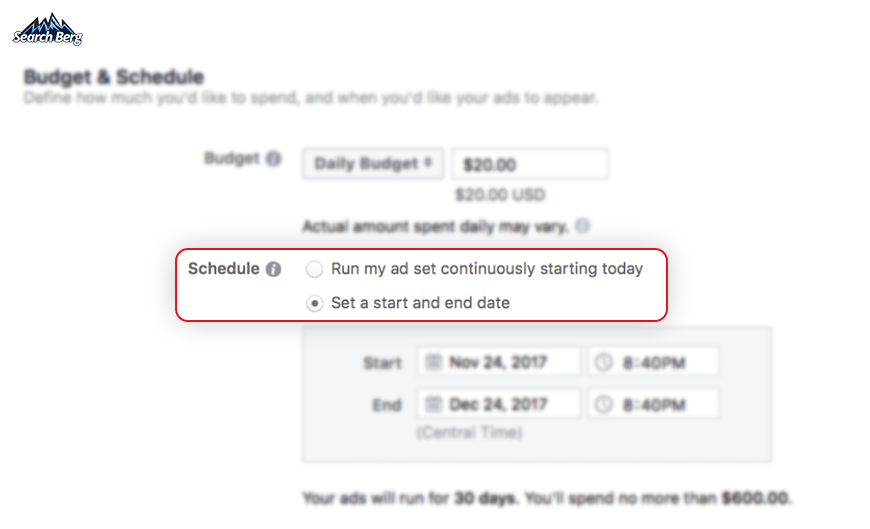
Both scheduling options can be effective in different contexts. However, promoting on Instagram during peak times, i.e. when users are most active, generally costs more. So, running during other business hours or off-hours can reduce your ad costs.
5. Ad Quality and Relevance
The quality of your ads can affect how well or poorly they perform. This, in turn, can affect their costs. Since interactions, defined by likes, comments, and clicks, are a key performance indicator for Instagram ads, ads with higher interactions can help optimize budgets.
When promoting on Instagram, you should focus on minimizing your cost per interaction by prioritizing ad quality and relevance. Relevance refers to audience targeting, i.e., choosing the right interests and behaviors when creating a custom audience for your ads on Instagram. Relevant ads help you ensure the right users are seeing your ads for the right cost.
6. Target Audience
You can create custom audiences when running ads on Instagram. The number of users your ads will reach depends on multiple factors, including locations, ages, and interests.
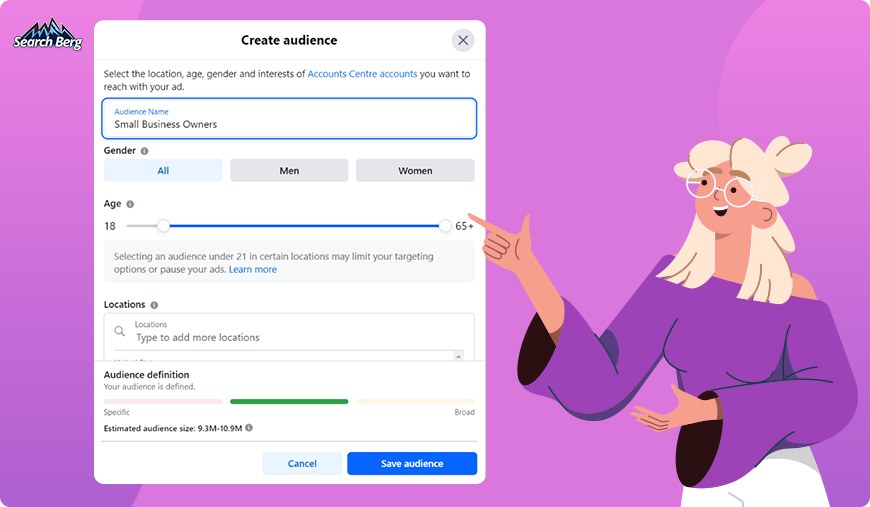
As an ad’s reach increases, so do its costs because it’ll be pushed to a larger audience. So, even the target audience for your ad can affect how much you spend on it. Some geographical regions may also be more competitive in terms of advertising than others. This would drive up costs, too.
7. Bidding Strategy
Instagram uses a bidding system just like any other social platform that lets users advertise. There are many strategies you can explore, including:
- Lowest Cost: The goal here is to get the best results possible with the least spend. This can be an automatic setting where Instagram’s algorithm chooses bids that help achieve this goal within your budget.
- Cost Cap: This strategy lets you set the maximum amount you’re willing to spend for any user action you’re pursuing, like a CTA button click. Instagram will target users that fall within this budget but won’t surpass it.
- Minimum ROAS (Return on Ad Spend): If you decide how much return you’d like to achieve on your ad spend, you can input that amount into Instagram, and the algorithm will suggest bid amounts based on this strategy.
The bidding strategy you use can make all the difference in determining your ad costs.
If you’re new to Instagram advertising, consider consulting with our social media management company for further guidance on bidding strategies!
So, How Much Do Instagram Ads Actually Cost?
Ultimately, too many elements affect the cost of Instagram ads for there to be a fixed standard rate. However, you can expect to pay a certain range based on the metric you select for calculation. Here’s a brief breakdown:
1. Cost Per Click (CPC)
The basic Cost Per Click (CPC) metric is determined by the amount of money you spend for each click your ad receives. On Instagram, you can expect to pay anywhere from $0.50 to $2.00 per click, depending on the factors discussed above.
2. Cost Per Engagement (CPE)
Instagram defines engagement as clicks, shares, likes, comments, and saves. If you use Cost Per Engagement (CPE) as your metric for promoting on Instagram, your ad costs might range from $0.01 to $0.08.
3. Cost Per Mille (CPM)
Impressions are another metric you can use to calculate your ad costs on Instagram. Cost Per Mille (CPM) takes into account the amount an advertiser is charged for every thousand impressions or views their ad gets. Promoting on Instagram using this metric can cost you around $2.50 to $3.50.
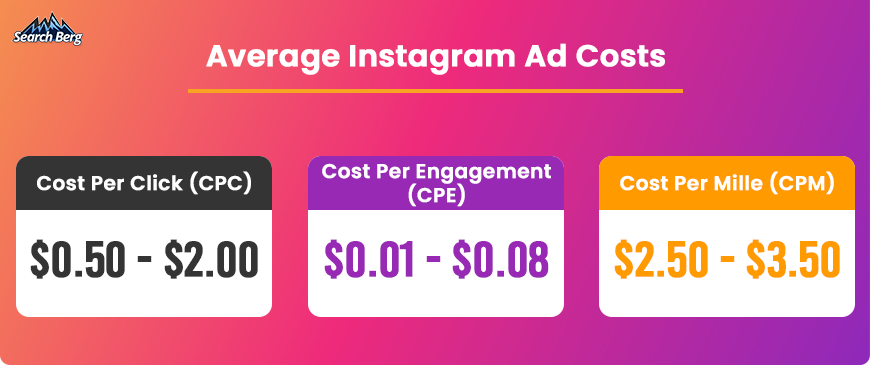
How to Reduce Your Instagram Ad Costs
Paying to promote on Instagram can run up some hefty costs without careful strategizing. It’s important to adopt methods that help you lower costs as much as possible without compromising on the results you’re pursuing.
Here are the top budget optimization tips from our social media management experts:
1. Set Clear Advertising Goals
Well-defined goals can make or break your advertising campaigns. When you know exactly what you’re hoping to achieve with an ad, you can define metrics to track and optimize costs based on their performance.
For instance, if your goal is to increase website visits, you can track cost-per-click (CPC) metrics for your ad and see if you’re getting a good return on ad spend (ROAS).
2. Target the Right Audience
As discussed earlier, targeting the right audience helps you ensure your ad budget is spent reaching the right people. When your ads are shown to users who are the most likely to engage with them, it increases your return on investment.
Targeting the right audience also means determining the right times to display your ads. Running ads continuously isn’t within the budget of most small advertisers, which leaves them with the option to set specified ad scheduling options. Depending on the industry and location of your target audience, you can likely figure out active or peak times for running ads.
Instagram and its parent company Meta also offer insights on active times to help you schedule ads. Use these insights to target your audience when most of it is online!
3. Create Compelling Content
Since quality is a critical factor affecting ad costs on Instagram, prioritizing it can be a game changer for advertisers looking to minimize their budget.
Make your ad content—copy and visuals alike—as compelling as possible. Doing so entails researching your audience’s interests and online behaviors. Find answers to questions like, “What kind of content does my audience like to consume?” and incorporate them into your ads.
If your ad is able to hook users, it’ll ultimately perform better. This means you’ll need to spend less on making more ads and have a few high-quality ads that actually deliver good results.
4. Test and Refine Your Ads
A/B testing is an ingenious way to find out what works and what doesn’t when promoting on Instagram. It allows you to run one type of ad alongside another and compare the results. You can use A/B testing to gain insights about different ad formats, copy, visual elements, and even custom audience segments.
You can select any campaign on Meta Ads Manager and enable the A/B testing option to gain insights.
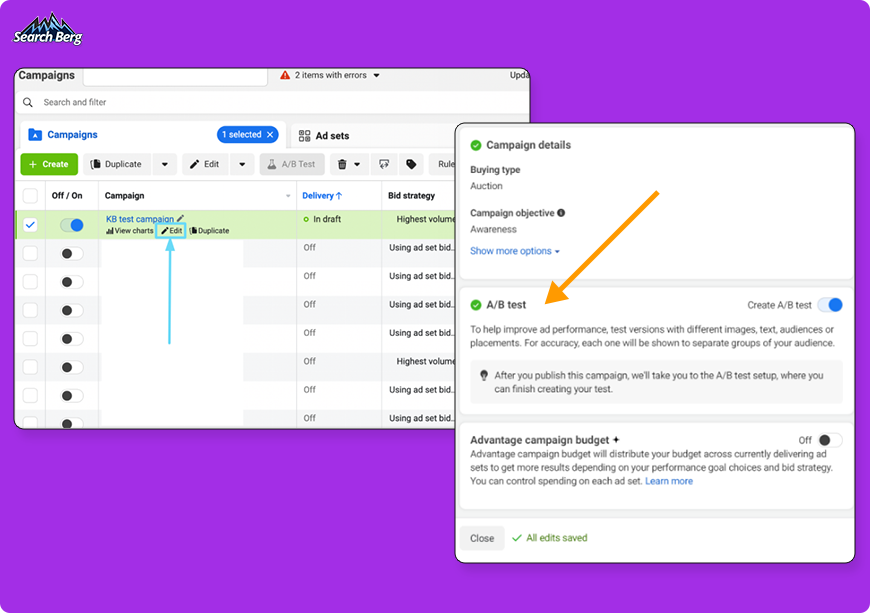
Set aside a portion of your Instagram advertising budget for A/B testing. Monitor and analyze the insights to determine which ad elements are the most effective for achieving your goals. Doing so will help you refine your ads to get the best results possible and optimize your costs at the same time.
5. Monitor and Analyze Insights
Even without A/B testing, Instagram allows advertisers to monitor their ad analytics.
Ad analytics include any goal-defining metrics you’ve chosen, along with other performance indicators like engagement and conversions. All of these analytics are built into the Meta Ads Manager that you’ll be using to run your ad campaigns on Instagram, so take advantage of them!
Analyzing insights helps you stay on top of trends, identify ineffective ad elements, and understand user behavior. When you know what performs best, you can optimize your budget to target it more closely instead of wasting it on irrelevant ads and user segments.
Start Spending Less and Achieving More With Global-marketing Inc.!
Instagram will continue to be a leading platform for online marketers and brands in 2024. Despite your industry, leveraging the app’s plentiful advertising options is a no-brainer if you want to grow online — and so is partnering with us!
Global-marketing Inc. is an award-winning SEO company ready to help you beat online competition with real strategies that actually work.
With skilled experts and years of experience under our belt, we have all the social media marketing solutions you’re looking for. Our team thoroughly audits your site and identifies opportunities for growth based on your goals.
Give us a call at +1(833)405-1025 or schedule a free consultation today to get started!












